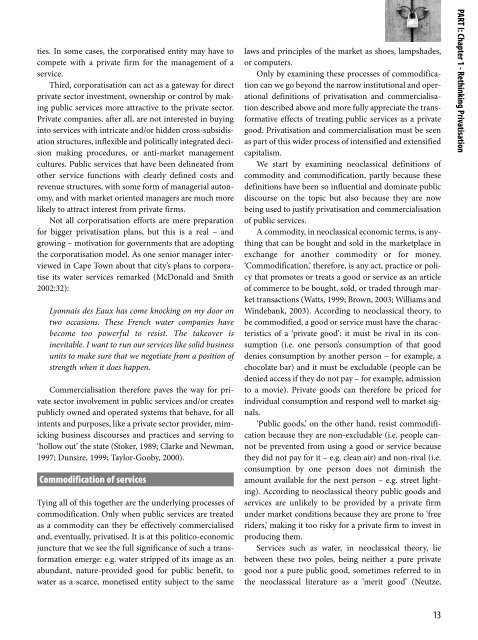Rethinking Privatization Towards a Critical Theoretical Perspective
Rethinking Privatization Towards a Critical Theoretical Perspective
Rethinking Privatization Towards a Critical Theoretical Perspective
You also want an ePaper? Increase the reach of your titles
YUMPU automatically turns print PDFs into web optimized ePapers that Google loves.
ties. In some cases, the corporatised entity may have tocompete with a private firm for the management of aservice.Third, corporatisation can act as a gateway for directprivate sector investment, ownership or control by makingpublic services more attractive to the private sector.Private companies, after all, are not interested in buyinginto services with intricate and/or hidden cross-subsidisationstructures, inflexible and politically integrated decisionmaking procedures, or anti-market managementcultures. Public services that have been delineated fromother service functions with clearly defined costs andrevenue structures, with some form of managerial autonomy,and with market oriented managers are much morelikely to attract interest from private firms.Not all corporatisation efforts are mere preparationfor bigger privatisation plans, but this is a real – andgrowing – motivation for governments that are adoptingthe corporatisation model. As one senior manager interviewedin Cape Town about that city’s plans to corporatiseits water services remarked (McDonald and Smith2002:32):Lyonnais des Eaux has come knocking on my door ontwo occasions. These French water companies havebecome too powerful to resist. The takeover isinevitable. I want to run our services like solid businessunits to make sure that we negotiate from a position ofstrength when it does happen.Commercialisation therefore paves the way for privatesector involvement in public services and/or createspublicly owned and operated systems that behave, for allintents and purposes, like a private sector provider, mimickingbusiness discourses and practices and serving to‘hollow out’ the state (Stoker, 1989; Clarke and Newman,1997; Dunsire, 1999; Taylor-Gooby, 2000).Commodification of servicesTying all of this together are the underlying processes ofcommodification. Only when public services are treatedas a commodity can they be effectively commercialisedand, eventually, privatised. It is at this politico-economicjuncture that we see the full significance of such a transformationemerge: e.g. water stripped of its image as anabundant, nature-provided good for public benefit, towater as a scarce, monetised entity subject to the samelaws and principles of the market as shoes, lampshades,or computers.Only by examining these processes of commodificationcan we go beyond the narrow institutional and operationaldefinitions of privatisation and commercialisationdescribed above and more fully appreciate the transformativeeffects of treating public services as a privategood. Privatisation and commercialisation must be seenas part of this wider process of intensified and extensifiedcapitalism.We start by examining neoclassical definitions ofcommodity and commodification, partly because thesedefinitions have been so influential and dominate publicdiscourse on the topic but also because they are nowbeing used to justify privatisation and commercialisationof public services.A commodity, in neoclassical economic terms, is anythingthat can be bought and sold in the marketplace inexchange for another commodity or for money.‘Commodification,’ therefore, is any act, practice or policythat promotes or treats a good or service as an articleof commerce to be bought, sold, or traded through markettransactions (Watts, 1999; Brown, 2003; Williams andWindebank, 2003). According to neoclassical theory, tobe commodified, a good or service must have the characteristicsof a ‘private good’: it must be rival in its consumption(i.e. one person’s consumption of that gooddenies consumption by another person – for example, achocolate bar) and it must be excludable (people can bedenied access if they do not pay – for example, admissionto a movie). Private goods can therefore be priced forindividual consumption and respond well to market signals.‘Public goods,’ on the other hand, resist commodificationbecause they are non-excludable (i.e. people cannotbe prevented from using a good or service becausethey did not pay for it – e.g. clean air) and non-rival (i.e.consumption by one person does not diminish theamount available for the next person – e.g. street lighting).According to neoclassical theory public goods andservices are unlikely to be provided by a private firmunder market conditions because they are prone to ‘freeriders,’ making it too risky for a private firm to invest inproducing them.Services such as water, in neoclassical theory, liebetween these two poles, being neither a pure privategood nor a pure public good, sometimes referred to inthe neoclassical literature as a ‘merit good’ (Neutze,PART I: Chapter 1 - <strong>Rethinking</strong> Privatisation13
















